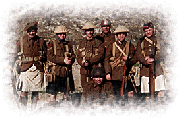Feature Articles - History of the 13th Battalion Black Watch
 On August 1, 1914,
Sir Robert Borden,
Prime Minister for Canada, offered the services of Canada's help to Great
Britain in her war against Germany.
On August 1, 1914,
Sir Robert Borden,
Prime Minister for Canada, offered the services of Canada's help to Great
Britain in her war against Germany.
Great Britain immediately accepted this offer. Almost immediately, approximately 300 men of the Black Watch of Canada (the Royal Highlanders) volunteered. The Royal Highlanders of Canada gave birth to three Black Watch Battalions during the war. By the end of August, the regiment numbered over 1,000 men. As the numbers grew, volunteers from the Royal Highlanders were incorporated into the 13th Battalion.
Over 60% of the initial recruits were of British origin. A large percentage were former British soldiers who had relocated to Canada at the turn of the century. While still in Canada, the 13th Battalion was placed in the 3rd Brigade of the 1st Division along with the 14th, 15th, and 16th battalions.
In October of 1914, the 1st Division departed for Great Britain. The Division remained in Great Britain for additional training until February 10th, 1915. On February 16, 1915, the unit departed for France. After spending time in France, in April of 1915, the battalion was used to reinforce British and Canadian lines in Ypres sector.
The April 1915 battle for Ypres was the site of the first use of poison gas during the war. Despite the surprise of the German attack and their use of gas, the Canadian forces were able to stabilize their lines and fall back in good order to more defensible positions.
During its first actions of the war, the 13th Battalion lost 120 officers and 454 other ranks. The unit also won its first Victorian Cross (England's highest military honour) and the first VC for the Canadian Expeditionary Force (CEF). In his reports on the action, Sir John French was recorded as saying, "the bearing and conduct of the splendid Canadian troops averted a serious disaster."
During the remainder of 1915 and 1916, the 13th Battalion fought at battles in numerous locations including Festubert, Messines, Bailleul, Givenchy, Flanders, and the Somme.
On April 9th, 1917, the 13th Battalion went over the top in the Battle of Vimy Ridge. This epic Canadian battle is one of the most important in Canada's military history. During the course of the action, the battalion lost 39 men and 147 wounded
In 1918, the battalion took part in battles around Amiens, Chaulnes, and Roye. In August 1918, the battalion attacked the German forces outside Hangar Wood. Here Private J.B. Croak and Corporal H.J. Good won two more of the unit's 5 Victorian Crosses awarded during the war.
The 13th Battalion Black Watch served with distinction from 1914 to 1919. During the course of the war, the battalion, numbering approximately 1,000 men while at full strength, suffered 5,881 casualties, of which 1,105 were fatalities.
Article reproduced by permission of the Black Watch Home Page (since defunct)
"Bellied" was a term used to describe when a tank's underside was caught upon an obstacle such that its tracks were unable to grip the earth.
- Did you know?
